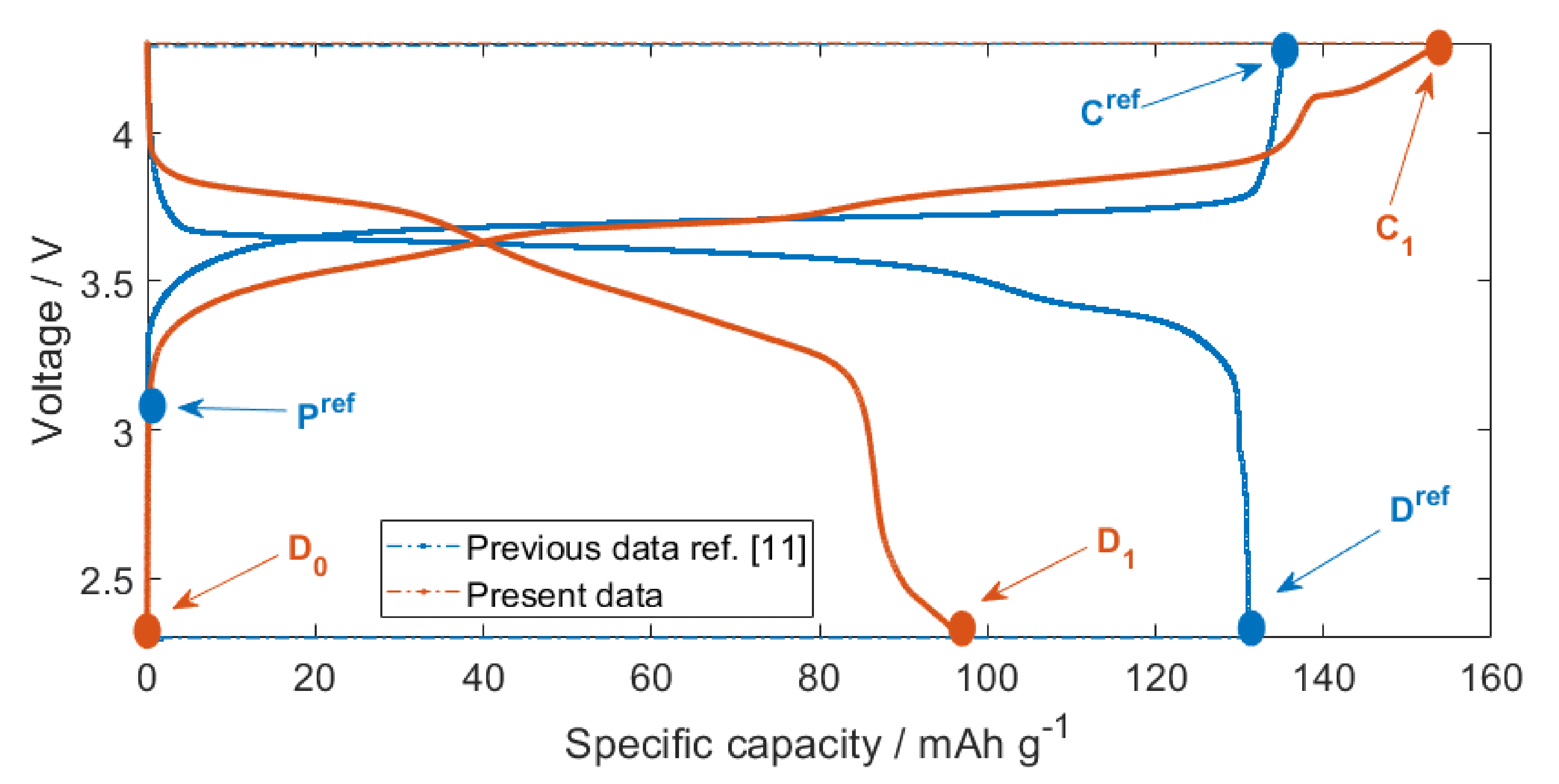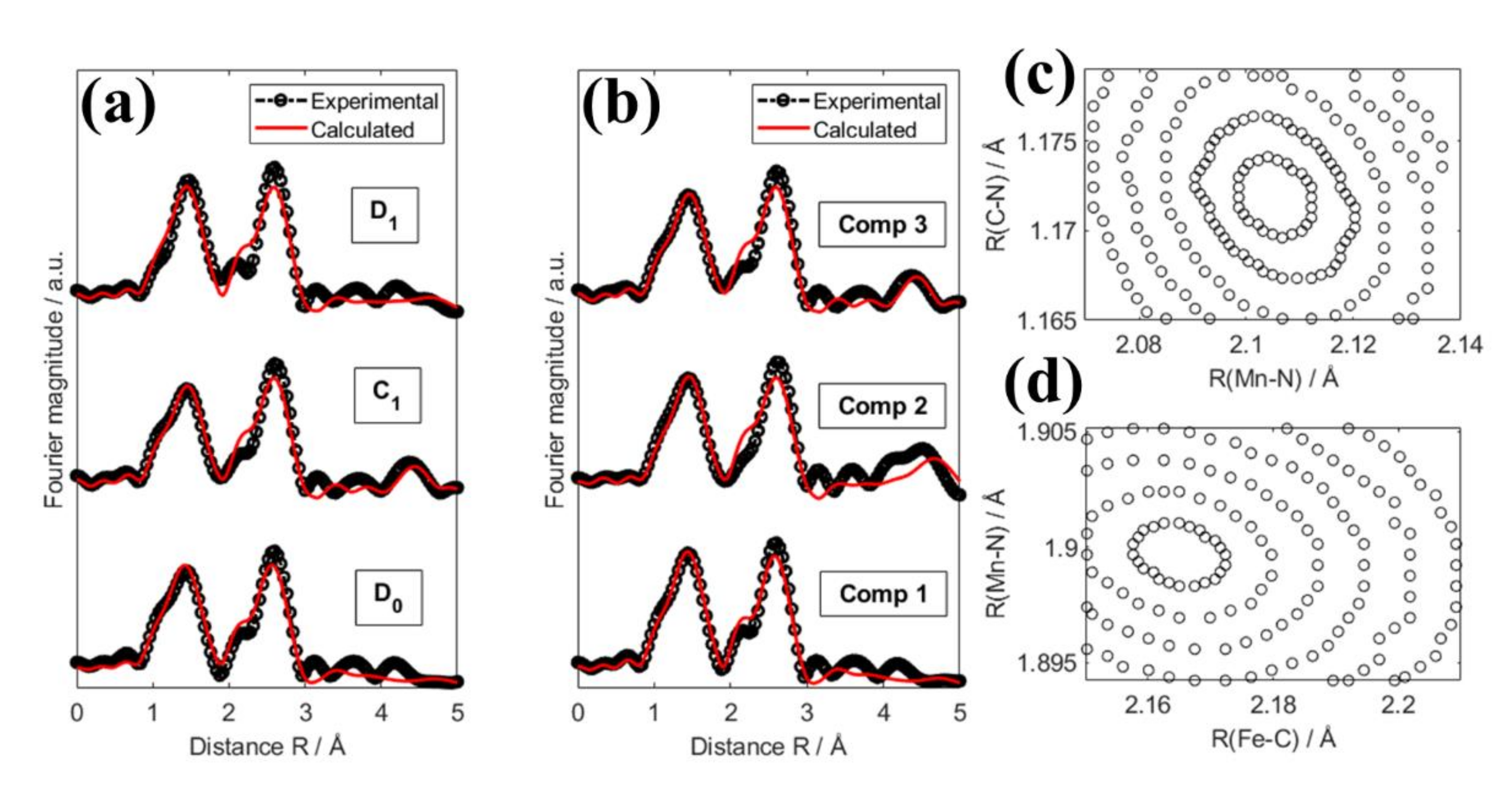Structural Effects of Anomalous Current Densities on Manganese Hexacyanoferrate for Li-Ion Batteries
Abstract
1. Introduction
2. Materials and Methods
3. Results
3.1. Electrochemistry
3.2. X-ray Absorption Near Edge Spectroscopy (XANES)
3.3. Operando XANES and MCR-ALS Data Analysis
3.4. EXAFS
4. Discussion
Supplementary Materials
Author Contributions
Funding
Acknowledgments
Conflicts of Interest
References
- Reddy, M.V.; Mauger, A.; Julien, C.M.; Paolella, A.; Zaghib, K. Brief History of Early Lithium-Battery Development. Materials (Basel) 2020, 13, 1884. [Google Scholar] [CrossRef]
- Xie, J.; Lu, Y. A retrospective on lithium-ion batteries. Nat. Commun. 2020, 11, 2499. [Google Scholar] [CrossRef]
- United Nations Sustainable Development—17 Goals to Transform Our World; United Nations: New York, NY, USA, 2015.
- Abada, S.; Marlair, G.; Lecocq, A.; Petit, M.; Sauvant-Moynot, V.; Huet, F. Safety focused modeling of lithium-ion batteries: A review. J. Power Sources 2016, 306, 178–192. [Google Scholar] [CrossRef]
- Omariba, Z.; Zhang, L.; Sun, D. Review on Health Management System for Lithium-Ion Batteries of Electric Vehicles. Electronics 2018, 7, 72. [Google Scholar] [CrossRef]
- Ali, M.U.; Zafar, A.; Nengroo, S.H.; Hussain, S.; Alvi, M.J.; Kim, H.-J. Towards a Smarter Battery Management System for Electric Vehicle Applications: A Critical Review of Lithium-Ion Battery State of Charge Estimation. Energies 2019, 12, 446. [Google Scholar] [CrossRef]
- Tran, M.K.; Fowler, M. A review of lithium-ion battery fault diagnostic algorithms: Current progress and future challenges. Algorithms 2020, 13, 62. [Google Scholar] [CrossRef]
- Paolella, A.; Faure, C.; Timoshevskii, V.; Marras, S.; Bertoni, G.; Guerfi, A.; Vijh, A.; Armand, M.; Zaghib, K. A review on hexacyanoferrate-based materials for energy storage and smart windows: Challenges and perspectives. J. Mater. Chem. A 2017, 5, 18919–18932. [Google Scholar] [CrossRef]
- Wang, B.; Han, Y.; Wang, X.; Bahlawane, N.; Pan, H.; Yan, M.; Jiang, Y. Prussian Blue Analogs for Rechargeable Batteries. iScience 2018, 3, 110–133. [Google Scholar] [CrossRef] [PubMed]
- Moritomo, Y.; Takachi, M.; Kurihara, Y.; Matsuda, T. Synchrotron-Radiation X-Ray Investigation of Li+/Na+ Intercalation into Prussian Blue Analogues. Adv. Mater. Sci. Eng. 2013, 2013, 967285. [Google Scholar] [CrossRef]
- Mullaliu, A.; Asenbauer, J.; Aquilanti, G.; Passerini, S.; Giorgetti, M. Highlighting the Reversible Manganese Electroactivity in Na-Rich Manganese Hexacyanoferrate Material for Li- and Na-Ion Storage. Small Methods 2020, 4, 1900529. [Google Scholar] [CrossRef]
- Mullaliu, A.; Aquilanti, G.; Conti, P.; Giorgetti, M.; Passerini, S. Effect of Water and Alkali-Ion Content on the Structure of Manganese(II) Hexacyanoferrate(II) by a Joint Operando X-ray Absorption Spectroscopy and Chemometric Approach. ChemSusChem 2020, 13, 608–615. [Google Scholar] [CrossRef] [PubMed]
- Mullaliu, A.; Gaboardi, M.; Plaisier, J.R.; Passerini, S.; Giorgetti, M. Lattice Compensation to Jahn–Teller Distortion in Na-Rich Manganese Hexacyanoferrate for Li-Ion Storage: An Operando Study. ACS Appl. Energy Mater. 2020, 3, 5728–5733. [Google Scholar] [CrossRef]
- Leriche, J.-B.; Hamelet, S.; Shu, J.; Morcrette, M.; Masquelier, C.; Ouvrard, G.; Zerrouki, M.; Soudan, P.; Belin, S.; Elkaïm, E.; et al. An Electrochemical Cell for Operando Study of Lithium Batteries Using Synchrotron Radiation. J. Electrochem. Soc. 2010, 157, A606–A610. [Google Scholar] [CrossRef]
- Briois, V.; La Fontaine, C.; Belin, S.; Barthe, L.; Moreno, T.; Pinty, V.; Carcy, A.; Girardot, R.; Fonda, E. ROCK: The new Quick-EXAFS beamline at SOLEIL. J. Phys. Conf. Ser. 2016, 712, 012149. [Google Scholar] [CrossRef]
- Ravel, B.; Newville, M. ATHENA, ARTEMIS, HEPHAESTUS: Data analysis for X-ray absorption spectroscopy using IFEFFIT. J. Synchrotron Rad. 2005, 12, 537–541. [Google Scholar] [CrossRef]
- de Juan, A.; Jaumot, J.; Tauler, R. Multivariate Curve Resolution (MCR). Solving the mixture analysis problem. Anal. Methods 2014, 6, 4964. [Google Scholar] [CrossRef]
- Fehse, M.; Iadecola, A.; Sougrati, M.T.; Conti, P.; Giorgetti, M.; Stievano, L. Applying chemometrics to study battery materials: Towards the comprehensive analysis of complex operando datasets. Energy Storage Mater. 2019, 18, 328–337. [Google Scholar] [CrossRef]
- Filipponi, A.; Di Cicco, A.; Natoli, C.R. X-ray-absorption spectroscopy and n-body distribution functions in condensed matter. I. Theory. Phys. Rev. B 1995, 52, 15122–15134. [Google Scholar] [CrossRef]
- Filipponi, A.; Di Cicco, A. X-ray-absorption spectroscopy and n-body distribution functions in condensed matter. II. Data analysis and applications. Phys. Rev. B 1995, 52, 15135–15149. [Google Scholar] [CrossRef]
- Giorgetti, M.; Berrettoni, M.; Filipponi, A.; Kulesza, P.J.; Marassi, R. Evidence of four-body contributions in the EXAFS spectrum of Na2Co[Fe(CN)6]. Chem. Phys. Lett. 1997, 275, 108–112. [Google Scholar] [CrossRef]
- Giorgetti, M.; Berrettoni, M. Structure of Fe/Co/Ni Hexacyanoferrate As Probed by Multiple Edge X-ray Absorption Spectroscopy. Inorg. Chem. 2008, 47, 6001–6008. [Google Scholar] [CrossRef]
- Giorgetti, M.; Guadagnini, L.; Tonelli, D.; Minicucci, M.; Aquilanti, G. Structural characterization of electrodeposited copper hexacyanoferrate films by using a spectroscopic multi-technique approach. Phys. Chem. Chem. Phys. 2012, 14, 5527. [Google Scholar] [CrossRef] [PubMed]
- Song, J.; Wang, L.; Lu, Y.; Liu, J.; Guo, B.; Xiao, P.; Lee, J.-J.; Yang, X.-Q.; Henkelman, G.; Goodenough, J.B. Removal of Interstitial H2O in Hexacyanometallates for a Superior Cathode of a Sodium-Ion Battery. J. Am. Chem. Soc. 2015, 137, 2658–2664. [Google Scholar] [CrossRef]
- Hedin, L.; Lundqvist, B.I.; Lundqvist, S. Local exchange-correlation potentials. Solid State Commun. 1971, 9, 537–541. [Google Scholar] [CrossRef]
- Krause, M.O.; Oliver, J.H. Natural widths of atomic K and L levels, K α X-ray lines and several K L L Auger lines. J. Chem. Phys. Ref. Data 1979, 8, 329–338. [Google Scholar] [CrossRef]






| D0 | C1 | D1 | Component 1 | Component 2 | Component 3 | |
|---|---|---|---|---|---|---|
| Fe-C/Å | 1.857(3) | 1.894(6) | 1.878(2) | 1.864(2) | 1.900(2) | 1.895(2) |
| σ2 Fe-C/Å2 | 0.0031(5) | 0.0033(5) | 0.0027(4) | 0.0022(2) | 0.0030(4) | 0.0029(5) |
| C≡N/Å | 1.190(6) | 1.172(7) | 1.181(2) | 1.187(2) | 1.172(3) | 1.170(3) |
| σ2 C≡N/Å2 | 0.005(1) | 0.009(1) | 0.0087(5) | 0.005(1) | 0.012(1) | 0.007(1) |
| Mn-Neq/Å | 2.10(2) ** | 1.98(2) ** | 2.150(4) * | 2.09(1) ** | 2.10(1) ** | 1.986(6) ** |
| σ2 Mn-Neq/Å2 | 0.010(2) | 0.008(2) | 0.011(2) | 0.010(1) | 0.002(1) | 0.008(2) |
| Mn-Nax/Å | 2.34(2) *** | 2.19(2) *** | / | 2.35(2) *** | 2.17(1) *** | 2.18(1) *** |
| σ2 Mn-Neq/Å2 | 0.018(5) | 0.018(3) | / | 0.014(3) | 0.014(4) | 0.018(3) |
| σ 2 Fe-C-N/deg2 | 12(5) | 14(8) | 44(20) | 19(5) | 16(10) | 9(5) |
| σ2 Mn-N-C/deg2 | 4(3) | 4(3) | 4(3) | 4(3) | 28(15) | 4(3) |
| θ Fe-C-N/deg | 180 | 180 | 180 | 180 | 180 | 180 |
| θ Mn-N-C/deg | 180 | 180 | 180 | 180 | 180 | 180 |
| E0 Mn | 6540(1) | 6546(1) | 6542.4(8) | 6540(1) | 6541(2) | 6547.6(8) |
| E0 Fe | 7116.1(6) | 7117.7(4) | 7117.4(2) | 7116.6(3) | 7117.7(5) | 7117.8(5) |
| S02 Mn | 0.65(3) | 0.65(3) | 0.65(3) | 0.65(3) | 0.65(3) | 0.65(3) |
| S02 Fe | 0.80(3) | 0.80(3) | 0.80(3) | 0.80(3) | 0.80(3) | 0.80(3) |
| χ2-like residual/(10−6) | 1.29 | 1.38 | 2.65 | 4.76 | 7.53 | 4.26 |
Publisher’s Note: MDPI stays neutral with regard to jurisdictional claims in published maps and institutional affiliations. |
© 2020 by the authors. Licensee MDPI, Basel, Switzerland. This article is an open access article distributed under the terms and conditions of the Creative Commons Attribution (CC BY) license (http://creativecommons.org/licenses/by/4.0/).
Share and Cite
Mullaliu, A.; Belin, S.; Stievano, L.; Giorgetti, M.; Passerini, S. Structural Effects of Anomalous Current Densities on Manganese Hexacyanoferrate for Li-Ion Batteries. Appl. Sci. 2020, 10, 7573. https://doi.org/10.3390/app10217573
Mullaliu A, Belin S, Stievano L, Giorgetti M, Passerini S. Structural Effects of Anomalous Current Densities on Manganese Hexacyanoferrate for Li-Ion Batteries. Applied Sciences. 2020; 10(21):7573. https://doi.org/10.3390/app10217573
Chicago/Turabian StyleMullaliu, Angelo, Stéphanie Belin, Lorenzo Stievano, Marco Giorgetti, and Stefano Passerini. 2020. "Structural Effects of Anomalous Current Densities on Manganese Hexacyanoferrate for Li-Ion Batteries" Applied Sciences 10, no. 21: 7573. https://doi.org/10.3390/app10217573
APA StyleMullaliu, A., Belin, S., Stievano, L., Giorgetti, M., & Passerini, S. (2020). Structural Effects of Anomalous Current Densities on Manganese Hexacyanoferrate for Li-Ion Batteries. Applied Sciences, 10(21), 7573. https://doi.org/10.3390/app10217573








